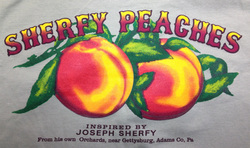
One of the reasons that fruit trees figure fairly prominently in The Bent Reed is that they figure prominently in many diaries of the period. By late June 1863, the Civil War had been raging long enough that many of the farmlands of the South were in disarray. The Confederate soldiers who invaded Pennsylvania on their way to the Battle of Gettysburg delighted in the produce and animals on the North’s untouched farms, and wrote about Pennsylvania’s green bounty.
Before the Civil War, almost every farm had a small apple orchard that was used to produce cider, fruit for the home, and food for pigs. With new roads, canals and railroads providing better transportation, many farmers in the Gettysburg area began expanding their orchards in the 1840s and 1850s to produce fruit for the growing urban markets.
Before the Civil War, almost every farm had a small apple orchard that was used to produce cider, fruit for the home, and food for pigs. With new roads, canals and railroads providing better transportation, many farmers in the Gettysburg area began expanding their orchards in the 1840s and 1850s to produce fruit for the growing urban markets.
 Joseph Sherfy, 1840s.
Joseph Sherfy, 1840s.One example of this new, enterprising farmer was the Reverend Joseph Sherfy, who purchased 50 acres along the Emmitsburg Road, south of the town of Gettysburg, in 1842. Sherfy planted much of his land in peach trees, and by the time of the Civil War, his fresh, dried, and canned peaches were locally famous.
Joseph and Mary Sherfy and their six children were ready to help when the Union army reached Gettysburg on the first of July 1863. Joseph dragged a large water tub out to the road and kept it filled for the thirsty soldiers. Mary and her mother baked loaf after loaf of bread and handed them over to the army. The next day they were forced to evacuate their home. Their home ended up being the center of the whirlwind of war on July 2nd and 3rd, which is the reason I chose to put the fictional McCoombs farm right next to Sherfy’s farm.
Joseph and Mary Sherfy and their six children were ready to help when the Union army reached Gettysburg on the first of July 1863. Joseph dragged a large water tub out to the road and kept it filled for the thirsty soldiers. Mary and her mother baked loaf after loaf of bread and handed them over to the army. The next day they were forced to evacuate their home. Their home ended up being the center of the whirlwind of war on July 2nd and 3rd, which is the reason I chose to put the fictional McCoombs farm right next to Sherfy’s farm.

The Sherfy farm was in the thick of things because Union General Dan Sickles disobeyed his commanding officer, General George Meade. He moved his men onto a piece of high ground in the middle of the orchard instead of keeping them in a line that extended south of the town of Gettysburg to a hill called Little Round Top. This created a sharp bend in the line, a vulnerable salient that the Confederate army attacked from two sides. The fight in the peach orchard was one of the most hotly contested of the Gettysburg battle.
When Sherfy returned to his land on the 6th, he discovered that his house had been ransacked. At least seven artillery shells had hit it. The yard was covered with the family’s possessions, churned into the mud with body parts left over from the Confederate field hospital that had been in their barn. Bodies of dead men and horses lay strewn about everywhere. The ruins of the barn were filled with the charred remains of the men who had been unable to escape the fire that occurred when shells of the Union batteries scored a direct hit.
Undaunted, the Sherfys cleaned, replanted, and rebuilt, and for years sold peaches from the famous orchard.It was a popular destination for veterans who had fought in its fields and wanted to relive their experiences. One wall of the house supposedly was covered with photographs of veterans who had fought there. The farm today, which still has some holes from artillery shells, is owned by the National Park Service. At some point in the late 19th or early 20th century the peach trees were all removed, but the National Park Service restored them about 15 years ago, and Sherfy's Peaches are again being sold at Gettysburg.
When Sherfy returned to his land on the 6th, he discovered that his house had been ransacked. At least seven artillery shells had hit it. The yard was covered with the family’s possessions, churned into the mud with body parts left over from the Confederate field hospital that had been in their barn. Bodies of dead men and horses lay strewn about everywhere. The ruins of the barn were filled with the charred remains of the men who had been unable to escape the fire that occurred when shells of the Union batteries scored a direct hit.
Undaunted, the Sherfys cleaned, replanted, and rebuilt, and for years sold peaches from the famous orchard.It was a popular destination for veterans who had fought in its fields and wanted to relive their experiences. One wall of the house supposedly was covered with photographs of veterans who had fought there. The farm today, which still has some holes from artillery shells, is owned by the National Park Service. At some point in the late 19th or early 20th century the peach trees were all removed, but the National Park Service restored them about 15 years ago, and Sherfy's Peaches are again being sold at Gettysburg.





No comments:
Post a Comment